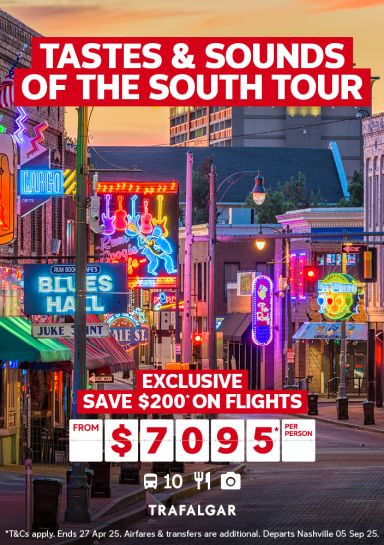Tours to Vietnam
Vietnam
Hungry for a holiday full of delicious cuisine, unique cultural immersions, lush greenery and plenty of super-friendly locals? Sounds like you’ve got a craving for Flight Centre’s latest range of Vietnam tour packages.
Whether you’re keen to immerse yourself in tradition and wander through ancient temples and vibrant markets with our discover Vietnam culture tours, or sail in style with Vietnam river cruise packages, there is an itinerary to suit every traveller.
Explore the heart of the country with Central Vietnam heritage tours, visiting Hoi An, Hue and the Marble Mountains along the way. Those hoping to get adventurous should join Northern Vietnam adventure treks through the lush landscapes of Sapa, while history buffs can gain insight into the events that shaped the nation with Vietnam war historical tours.
Head south to navigate the intricate network of rivers and canals with Mekong Delta Explorations. While you’re there, you can’t miss a chance to explore the bustling streets and lively atmosphere of Vietnam’s largest city with Ho Chi Minh excursions.
If you’re a sucker for inner city life, then a Hanoi City break is right up your alley. Spend days getting lost in vibrant street markets and experiencing the charm of Hanoi’s Old Quarter. All that exploring will no doubt work up a mean appetite. Beat your hunger and learn some new skills along the way by joining Vietnam culinary tours - you’ll be mastering pho, spring rolls and more in no time.
Top off your holiday by soaking up the sunshine on pristine sands with Vietnam beach vacations. With a bevvy of luxury resorts scattered along the coastline, you’ll be spoiled for choice on where to swim and soak up the renowned Vietnamese hospitality.
Frequently asked questions
Our Vietnam tour packages usually cover Hanoi, Ho Chi Minh City, Ha Long Bay, Hoi An and other popular destinations.
Some Vietnam tour packages include flights, while others do not. Check the package details and chat with your travel expert to include flights in your booking.
Yes! Most Vietnam packages feature guided tours that provide deep insights into historical sites and local life while taking you to bucket-list destinations. If you can’t find a package that has everything you’re looking for, chat with one of our travel experts to create a custom itinerary tailored to your needs.
Lightweight and modest clothing is best, along with comfortable footwear as you’ll be getting your steps up each day sightseeing. If you’re joining a motorcycle tour, be sure to pack long pants like jeans, while those hitting coastal areas will need their bathing suit and plenty of sunscreen.
Tours typically range from one week to two weeks, giving you plenty of time to explore the bustling cities, soak up the serenity of rural villages, get some clothes made in Hoi An and eat your bodyweight in banh mi. Got more time up your sleeve? Chat with our travel experts about extending your trip or even tacking on another tour.
The best time to visit Vietnam is generally from November to April, when you can make the most of pleasant weather. Keep in mind that Vietnam is a long country, so weather in the north will often differ to that in the south.
Yes, Vietnam is generally safe for tourists. If in doubt, we recommend you follow travel advisories, keep up to date with local guidelines and use common sense. (P.S. Don’t forget to grab some travel insurance, that way you’re covered in case something does go wrong)
Yes, many of our tours offer family-friendly activities, experiences and accommodation. If in doubt, chat with your local Flight Centre travel expert to find the right Vietnam tour option for your fam.
Most travellers require a visa, which can be obtained in advance online or on arrival. Check the specific requirements for your nationality by visiting the Vietnam visa and immigration website or chatting with your Flight Centre travel expert.
Of course! Mekong Delta cruises can easily be included in many of our packages, especially those visiting the southern parts of Vietnam.
Tours all over the world
Explore more of your favourite destinations
Help & support
© Flight Centre (NZ) Limited.
Lowest Airfare Guarantee is no longer valid at Flight Centre stores in New Zealand as of Thursday 14 July 2022. Click here for more information.
*Travel restrictions & conditions apply. Prices & taxes are in NZD and are correct as at the date of publication & are subject to availability and change without notice. Prices quoted are on sale until the dates specified unless otherwise stated or sold out prior. Prices are per person. We charge a Travel Expert Service Fee for bookings made with our travel experts in store, via email or over the phone and an Online Booking Fee for flight bookings made online. These fees are charged in addition to the advertised price and displayed fares. Merchant fees apply and depend on your chosen payment method. View Booking Terms and Conditions for more information.




















